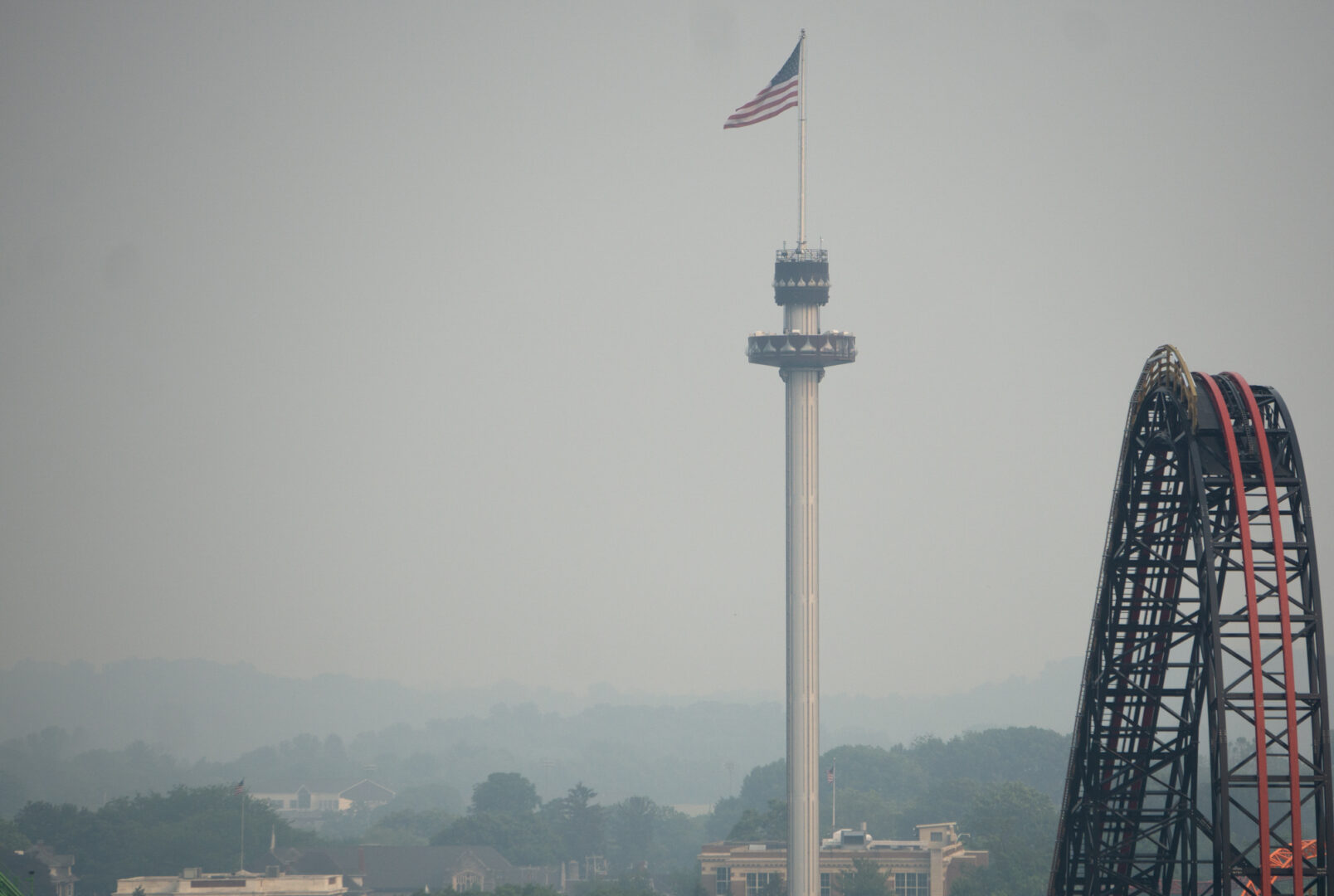
The Kissing Tower is shrouded in a haze at Hersheypark as smoke from Canadian wildfires filtered into Pennsylvania on June 8, 2023. The smoke degraded air quality across Pennsylvania and other states in the northeast. Jeremy Long - WITF News


The Kissing Tower is shrouded in a haze at Hersheypark as smoke from Canadian wildfires filtered into Pennsylvania on June 8, 2023. The smoke degraded air quality across Pennsylvania and other states in the northeast. Jeremy Long - WITF News

The Kissing Tower is shrouded in a haze at Hersheypark as smoke from Canadian wildfires filtered into Pennsylvania on June 8, 2023. The smoke degraded air quality across Pennsylvania and other states in the northeast. Jeremy Long - WITF News
A new Penn State study offers a different measurement system using wildfire forecasts and on-the-ground sensors to monitor the amount of smoke pollution, so people can get accurate and up-to-date information.
Data shows major wildfire smoke events like Central Pennsylvania saw last year could become more likely with climate change, and researchers are looking to find better measurement systems to keep people safe.
Manzhu Yu, the study’s lead author, said the popular websites like National Oceanic and Atmospheric Administration (NOAA) and the Weather Research and Forecasting model (WRF-Chem) that showed smoke intensity during last summer’s wildfires were often inaccurate — typically underestimating the amount of pollution in the air.
By comparing the estimated forecasts to recorded measurements, she found an underestimation of 100 micrograms per cubic meter. A measurement of 100 micrograms per cubic meter itself is already considered unhealthy to at-risk people by the Environmental Protection Agency.
Yu said, typically, exposure level is based on population. It takes into account the population density of an area and the concentration of pollution. So, if an area is highly populated, then exposure is typically higher than a less populated area, even if the two have the same pollution concentration.
To Yu, this measurement is good for annual assessments that look at long-term exposure to air pollution from sources like power plants or traffic, but not for short-term issues like wildfires, and it leaves out daily movement. People travel throughout the day, so their exposure will not be consistent.
“But for wildfire smoke, it is more dynamic,” she said. “The more helpful thing would be to have a dynamic exposure level for a particular small area, like a street block. The dynamic exposure level would be something that can be very helpful for real-time intervention.”
The Penn State team instead put together a measurement system including the more-broad smoke forecasts from NOAA and hourly data from on-the-ground sensors. They also used anonymous cell phone data to track how people move between areas with different levels of pollution.
The researchers said they found their data method to be more accurate because it includes more specific inputs, and using sensors that provide information hourly lets them update the statistics throughout the day.
When there is a wildfire smoke event, the United States Environmental Protection Agency advises people to keep windows and doors closed, stay inside when possible and limit strenuous activity.
Yu said accurate and regularly updated information could help people — especially those with preexisting conditions — take precautions and advocate for themselves.
“How can I communicate with my employers saying that I do want a break even though I’m indoors?” Yu said.
For example, she said some daycares asked parents not to drop off their children on days where the air quality was especially bad last year because it would be difficult for them to handle all of the kids with different health needs.
She said she would like to do further research, especially into environmental justice factors that show how wildfire smoke could especially impact marginalized communities.
Derek Mallia, a research assistant professor in the Department of Atmospheric Sciences at the University of Utah, said he agrees that further research into climate justice concerns would be beneficial.
He said wealthy people are more likely to have air conditioning, central air or jobs that allow them to stay inside when the air quality is especially bad.
Yu said she also plans on looking into multi-year analyses, focusing on the Northeast United States and its heavily populated cities.
StateImpact Pennsylvania is a collaboration among WITF, WHYY, and the Allegheny Front. Reporters Reid Frazier, Rachel McDevitt and Susan Phillips cover the commonwealth’s energy economy. Read their reports on this site, and hear them on public radio stations across Pennsylvania.
(listed by story count)
StateImpact Pennsylvania is a collaboration among WITF, WHYY, and the Allegheny Front. Reporters Reid Frazier, Rachel McDevitt and Susan Phillips cover the commonwealth’s energy economy. Read their reports on this site, and hear them on public radio stations across Pennsylvania.
Climate Solutions, a collaboration of news organizations, educational institutions and a theater company, uses engagement, education and storytelling to help central Pennsylvanians toward climate change literacy, resilience and adaptation. Our work will amplify how people are finding solutions to the challenges presented by a warming world.